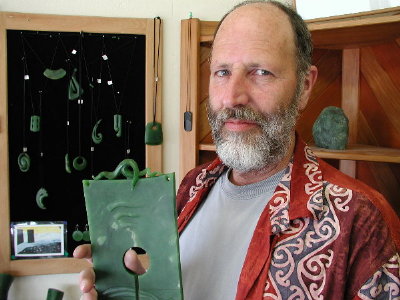A month ago, we met James the Gardener. Today, we introduce you to another Waiheke resident, a local artist who creates and sells his works at a main street studio/shop called Jade Jade Jade. The shop is always busy. And his pieces are so distinctive that wearing one turns out to be a great way to meet people on the island.

Q: Every time I come into your shop, there are new pieces. How many do you make?
A: I make about six big pieces—that can each take up to a month—each year. Then I make about five smaller tems each week, plus an occasional quite small and cheap—for the marketplace.
Q: Most of the smaller pieces are pendants that people wear; do you think of them as jewelry?
A: No, they´re little sculptures. They´re ideas that hang. I´m not really interested in decoration, and don´t really understand the world of jewelry.
Q: I´ve noticed that a lot of people in New Zealand wear jade. Why?
A: Mostly because of the Maoris, our native people, and their traditional use of it. To them, jade is the most valuable treasure. It´s the touchstone for their ancestors, and embodies the manna of their people.
Q: Is that true elsewhere? Or with any other stone?
A: It´s more true with jade than any other stone. And it happens in China, Europe, and Central America.
Q: What do you think makes jade so extraordinary?
A: It´s so durable they made axes with it in Neolithic times. And time has made it special. Jade is metamorphic, and goes through transformations you can see. There´s a story and history in each rock; it´s slow, fast, pure, and corrupt.
Q: How do you create your pieces?
A: Sometimes I start with an idea and sometimes the idea finds me. Each rock determines it, really. I have to find the story. It´s always a challenge. And the finished product is never as good as the primary idea.
Q: Is there a particular type of person who buys or wears jade?
A: Not at all. Even businessmen in Auckland wear them under their suits. It has nothing to do with their culture, wealth, or age.
Q: What do you think it means to people?
A: People wear it as a talisman. It´s a token of one´s connection with the earth, and of a migratory, nomadic people.
Q: What do you mean?
A: New Zealand was last place on earth to be colonized—the end of the line. When you live here, that imbues your sensibility. Jade is a way of finding commonality with our people back to the first Polynesians.
Q: How does that affect the forms you make?
A: Jade carving is the quintessential art of expressing that. I seek dynamic forms—curvilinear, infinite, open, and not tied down.
Q: Do you think your customers understand that?
A: I think so. I insist that the buyer knows what I was intending. That sounds egocentric, and I don´t mean it that way. Most people respond to the pieces and can´t even articulate why. But something touches them and they open up.
Q: Is that one of the perks of your job?
A: Very much so. I get to see what rhythms move people. It´s not immediate; it´s a spiritual thing—in the hearts of the people.
Q: Which gets back to jade helping people find a connection with the earth?
A: Yes. On the surface, it´s part of an environmental movement here. But I think it runs deeper. It´s part of our essence, and it´s coming back after fading for a while due to pressure from the American culture.
Q: What do you think might be the essence of American culture?
A: America is full of hope, always has been. But unfortunately, the way that´s presented now is materialistic hope.
Q: How do you stay inspired to do this every day?
A: If I´m going to spend a day or two on one piece, I need an idea—a good one. This is my way of reverence, of praying. What I do is quite monkish, really. So my body looks after itself, and I almost never lose interest or get tired.
Q: Have you always lived on Waiheke?
A: No, I was brought on across the way on the mainland. On the beach, really. Waiheke was on the horizon—where the moon came up.
Q: So how´d you end up here?
A: I´d been living and working in the city. The jobs weren´t working out, including one at the City Art Gallery. I couldn´t subject my children to the corruption and pretension of that world. So we came here.
Q: The art world was not for you?
A: Not at all. After I left, I didn´t visit a gallery or pick up an art book for 25 years. I do now. But I still have a distaste for the arty-farty world.
Q: Is this a better place to raise children?
A: Oh, yes. There is an enormous wonder throughout your life when your childhood is close to nature. I can´t imagine the emotional loss for children brought up in an apartment.
Q: And how´d you end up doing jade?
A: I had studied some sculpture, years ago. But when someone gave me some jade, I didn´t have to learn. I was making pieces within six weeks. I think I´d been waiting a long time.
Q: And I´ve kept you from your work for a long time. Thanks for sharing.
A: My pleasure. Enjoy your jade.
Tags: